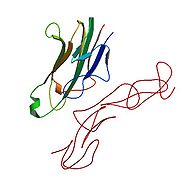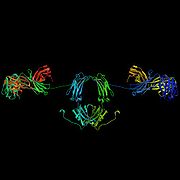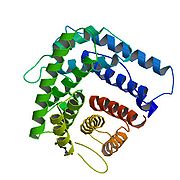
HLA A1-B8 haplotype
Encyclopedia
HLA A1-B8 is a multigene haplotype that covers the MHC Class I
region of the human major histocompatibility complex
on chromosome 6. A multigene haplotype is set of inherited alleles covering several genes, or gene-alleles, common multigene haplotypes are generally the result of descent by common ancestry (share a recent common ancestor for that segment of the chromosome). Chromosomal recombination
fragments multigene haplotypes as the distance to that ancestor increases in number of generations.
The haplotype can be written in an extended form covering the major histocompatibility loci as follows:
However, there are many other gene-alleles within the haplotype. In Europe A1-B8 is found, generally as part of the HLA A1-B8-DR3-DQ2
haplotype. This haplotype is 4.7 million nucleotide
s in length and the second longest haplotype identified within the human genome
. In Africa A1-B8 and India A1-B8 is associated with other genes and other variants of A*01
and B*08
. Among these were coeliac disease
, autoimmune active chronic hepatitis
, myasthenia gravis
, Adrenocortical hyperfunction-Cushing's syndrome
, primary biliary cirrhosis
. However as study sizes increased and D serotypes were described in more detail, the association of these loci moved from the MHC class I
However as study sizes increased and D serotypes were described in more detail, the association of these loci moved from the MHC class I
loci to the MHC class II
loci. Underlying this move was the HLA A1-B8-DR3-DQ2
haplotype, a haplotype that is in acute linkage disequilibrium
in the European population. This disequilibrium made it appear that A1 and other class I gene-alleles were disease factors, when these alleles were only attached to a long segment of conserved DNA that had disease associated genes on the other end. In at least 2 diseases, the risk of autoimmune disease extends beyond the class II region of the haplotype.
(SLE) (renal and central nervous system involvement) in Caucasian patients. Two-point haplotype analysis between TNFB(B*01 allele) and HLA show that the allele is in linkage disequilibrium with HLA-A1, Cw7, B8, C4A(Null), DR3, DQ2.5.


MHC class I
MHC class I molecules are one of two primary classes of major histocompatibility complex molecules and are found on every nucleated cell of the body...
region of the human major histocompatibility complex
Major histocompatibility complex
Major histocompatibility complex is a cell surface molecule encoded by a large gene family in all vertebrates. MHC molecules mediate interactions of leukocytes, also called white blood cells , which are immune cells, with other leukocytes or body cells...
on chromosome 6. A multigene haplotype is set of inherited alleles covering several genes, or gene-alleles, common multigene haplotypes are generally the result of descent by common ancestry (share a recent common ancestor for that segment of the chromosome). Chromosomal recombination
Genetic recombination
Genetic recombination is a process by which a molecule of nucleic acid is broken and then joined to a different one. Recombination can occur between similar molecules of DNA, as in homologous recombination, or dissimilar molecules, as in non-homologous end joining. Recombination is a common method...
fragments multigene haplotypes as the distance to that ancestor increases in number of generations.
The haplotype can be written in an extended form covering the major histocompatibility loci as follows:
HLA A*0101 : Cw*0701 : B*0801
However, there are many other gene-alleles within the haplotype. In Europe A1-B8 is found, generally as part of the HLA A1-B8-DR3-DQ2
HLA A1-B8-DR3-DQ2
HLA A1-B8-DR3-DQ2 haplotype is a multigene haplotype that covers a majority of the human major histocompatibility complex on chromosome 6...
haplotype. This haplotype is 4.7 million nucleotide
Nucleotide
Nucleotides are molecules that, when joined together, make up the structural units of RNA and DNA. In addition, nucleotides participate in cellular signaling , and are incorporated into important cofactors of enzymatic reactions...
s in length and the second longest haplotype identified within the human genome
Human genome
The human genome is the genome of Homo sapiens, which is stored on 23 chromosome pairs plus the small mitochondrial DNA. 22 of the 23 chromosomes are autosomal chromosome pairs, while the remaining pair is sex-determining...
. In Africa A1-B8 and India A1-B8 is associated with other genes and other variants of A*01
HLA-A1
HLA-A1 is a human leukocyte antigen serotype within HLA-A "A" serotype group. The serotype is determined by the antibody recognition of α1 subset of HLA-A α-chains. For A1, the alpha "A" chain are encoded by the HLA-A*01 allele group and the β-chain are encoded by B2M locus. This group...
and B*08
HLA-B8
HLA-B8 is an HLA-B serotype. The serotype identifies the HLA-B*08 gene products. HLA-B8, previously known as HL-A8 was one of the first identified of the HLA antigens. It coined the "Super B8" haplotype, also called the ancestral European haplotype because of its common occurrence in Europe,...
Disease associations
Philosophically, A1-B8 is more than just two gene-alleles. These gene-alleles are markers for a haplotype, a stretch of chromosome 6 that contains many gene alleles. In its natural history this haplotype underwent some atypical selection, at the end of the period of evolution it became the predominant haplotypes in North/Western European ancestors. Today however the collection of genes is associated with increased incidences of certain diseases. Despite the fact that the associations have been known almost as long as A1 and "A8" were known, the role of factors affecting disease are still not clear.A1-B8 and autoimmune diseases
A1-B8 serotype was associated with a number of diseases as "HL-A"' antigens were first being describedHistory and naming of human leukocyte antigens
Human leukocyte antigens began as a list of antigens identified as a result of transplant rejection. The list, HL-A1 to HL-A15. The antigens were identified based on serotypes that developed in transplant recipients, to donor antigens that could recognize one apparent antigen were found useful....
. Among these were coeliac disease
Coeliac disease
Coeliac disease , is an autoimmune disorder of the small intestine that occurs in genetically predisposed people of all ages from middle infancy onward...
, autoimmune active chronic hepatitis
Autoimmune hepatitis
Autoimmune Hepatitis is a disease of the liver that occurs when the body's immune system attacks cells of the liver. Anomalous presentation of human leukocyte antigen class II on the surface of hepatocytes, possibly due to genetic predisposition or acute liver infection, causes a cell-mediated...
, myasthenia gravis
Myasthenia gravis
Myasthenia gravis is an autoimmune neuromuscular disease leading to fluctuating muscle weakness and fatiguability...
, Adrenocortical hyperfunction-Cushing's syndrome
Cushing's syndrome
Cushing's syndrome is a hormone disorder caused by high levels of cortisol in the blood. This can be caused by taking glucocorticoid drugs, or by tumors that produce cortisol or adrenocorticotropic hormone or CRH...
, primary biliary cirrhosis
Primary biliary cirrhosis
Primary biliary cirrhosis, often abbreviated PBC, is an autoimmune disease of the liver marked by the slow progressive destruction of the small bile ducts within the liver. When these ducts are damaged, bile builds up in the liver and over time damages the tissue. This can lead to scarring,...
.

MHC class I
MHC class I molecules are one of two primary classes of major histocompatibility complex molecules and are found on every nucleated cell of the body...
loci to the MHC class II
MHC class II
MHC Class II molecules are found only on a few specialized cell types, including macrophages, dendritic cells and B cells, all of which are professional antigen-presenting cells ....
loci. Underlying this move was the HLA A1-B8-DR3-DQ2
HLA A1-B8-DR3-DQ2
HLA A1-B8-DR3-DQ2 haplotype is a multigene haplotype that covers a majority of the human major histocompatibility complex on chromosome 6...
haplotype, a haplotype that is in acute linkage disequilibrium
Linkage disequilibrium
In population genetics, linkage disequilibrium is the non-random association of alleles at two or more loci, not necessarily on the same chromosome. It is also referred to as to as gametic phase disequilibrium , or simply gametic disequilibrium...
in the European population. This disequilibrium made it appear that A1 and other class I gene-alleles were disease factors, when these alleles were only attached to a long segment of conserved DNA that had disease associated genes on the other end. In at least 2 diseases, the risk of autoimmune disease extends beyond the class II region of the haplotype.
Systemic lupus erythematosus
The "HL-A1,8 phenotype" was found to be associated with severe systemic lupus erythematosusSystemic lupus erythematosus
Systemic lupus erythematosus , often abbreviated to SLE or lupus, is a systemic autoimmune disease that can affect any part of the body. As occurs in other autoimmune diseases, the immune system attacks the body's cells and tissue, resulting in inflammation and tissue damage...
(SLE) (renal and central nervous system involvement) in Caucasian patients. Two-point haplotype analysis between TNFB(B*01 allele) and HLA show that the allele is in linkage disequilibrium with HLA-A1, Cw7, B8, C4A(Null), DR3, DQ2.5.
Type 1 diabetes
While type 1 diabetes shows an extended association on the HLA A1-B8-DR3-DQ2 haplotype, the association appears not to extend beyond the HLA-B locus. A recent study of DR3-DQ2/DR4-DQ8 phenotype found that A1-cw7-B8 was actually lower than expected relative to other A-B types, indicating that risk associated genes are located between B8 and DR3. A*0101 appears to alter risk for type 1 diabetes but not Cw7-B8. The type 1 diabetes example shows the inherent difficulty in the use of linkage analysis alone to cipher risk.
A1-B8 and allergic disease
In allergic disease A1,B8 were found to associate with allergic reactions in new-borns. A1, B8 was found increased in children with bronchial asthma and low IgA. However, some of this reaction can be attributed to the linkage of the HLA A1-B8-DR3-DQ2 haplotype to the IgA-less phenotype. A firmer association was found with atopies. A1,B8 where found more frequently in hay fever complicated by asthma or atopia relative to just hay fever. Further asthmatic patients with negative skin tests tended toward higher A1,B8 serotypes.A1-B8 and infectious disease

HIV
In the mid 1980s the association with A1-B8-DR3 and HIV progression appeared shortly after the discover of the virus. A1-B8 associated with more rapid progression to seropositivity, and was strongly associated with a rapid decline in T4 cells and development of HIV-related symptoms within four years of infection. The strongest associations were seen with A1-Cw7-B8 haplotype. C4 (complement 4) produces a null allele at on locus C4AQ. This locus in part of the HLA A1-B8-DR3-DQ2 haplotype (markers are A1, CW7, B8, BfS, C4AQ0, C4B1, DR3, DQ2) therefore one study concluded that C4AQ0 could explain the increased infectivity to HIV. The haplotype was further linked to false-tumor splenomegaly, CD8 lymphocytosis, and high IgG.Viral hepatitis
An association was seen between viral hepatitis and HLA-A1. Though, the association of A1 with autoimmune hepatitis with no anti-viral antibody was stronger than with chronic active hepatitis with anti-viral titer. The association with viral hepatitis was subsequently demonstrated and patients with antinuclear antibodies were more likely to have A1-B8-DR3. Currently studies point to association proximal the Cw*0702-B*0801 loci.Frequencies
| Ireland | 14.4 | 1 | ||
| Slovak | 11.9 | 1 | ||
| Northern Ireland | 11.5 | 1 | 1 | |
| Swedish | 11.5 | 1 | ||
| Dutch Netherlands | 9.8 | |||
| Yugoslavian | 9.7 | 1 | ||
| British | 9.7 | 1 | ||
| Hungarian | 9.4 | 1 | ||
| CEPH France | 8.5 | 1 | 1 | |
| German | 8.3 | 1 | ||
| Czech | 7.8 | 1 | ||
| Swiss | 6.7 | 3 | ||
| Belgium | 5.5 | 2 | ||
| Austria | 4.5 | 2 | ||
| Tuscan Italy | 4.3 | |||
| Ukraine | 4.3 | 3 | ||
| Italy | 4.2 | 1 | ||
| Basque | 4.2 | |||
| Portuguese | 4.2 | 2 | ||
| Polish | 4.0 | |||
| Uganda | 3.7 | 1 | ||
| Uralic | 3.1 | 3 | ||
| Spanish | 2.8 | 4 | ||
| http://www.allelefrequencies.net/test/searchHaplotypePart3.asp?Population=Romanian | Romania | 2.8 | ||
| Albania | 2.5 | |||
| Greek | 2.3 | |||
| http://www.allelefrequencies.net/test/searchHaplotypePart3.asp?Population=Greece%20North | Northern Greece | 2.1 | ||
| Crete | 1.9 | |||
| Luo Kenya | 1.7 | 2 | ||
| Nandi Kenya | 1.4 | 2 | ||
| Oman Arabia | 1.4 | |||
| Japanese | 0.1 | |||
| 1Cw*0701 (Eur.), ²Cw*0704 (Afr.) | ||||

